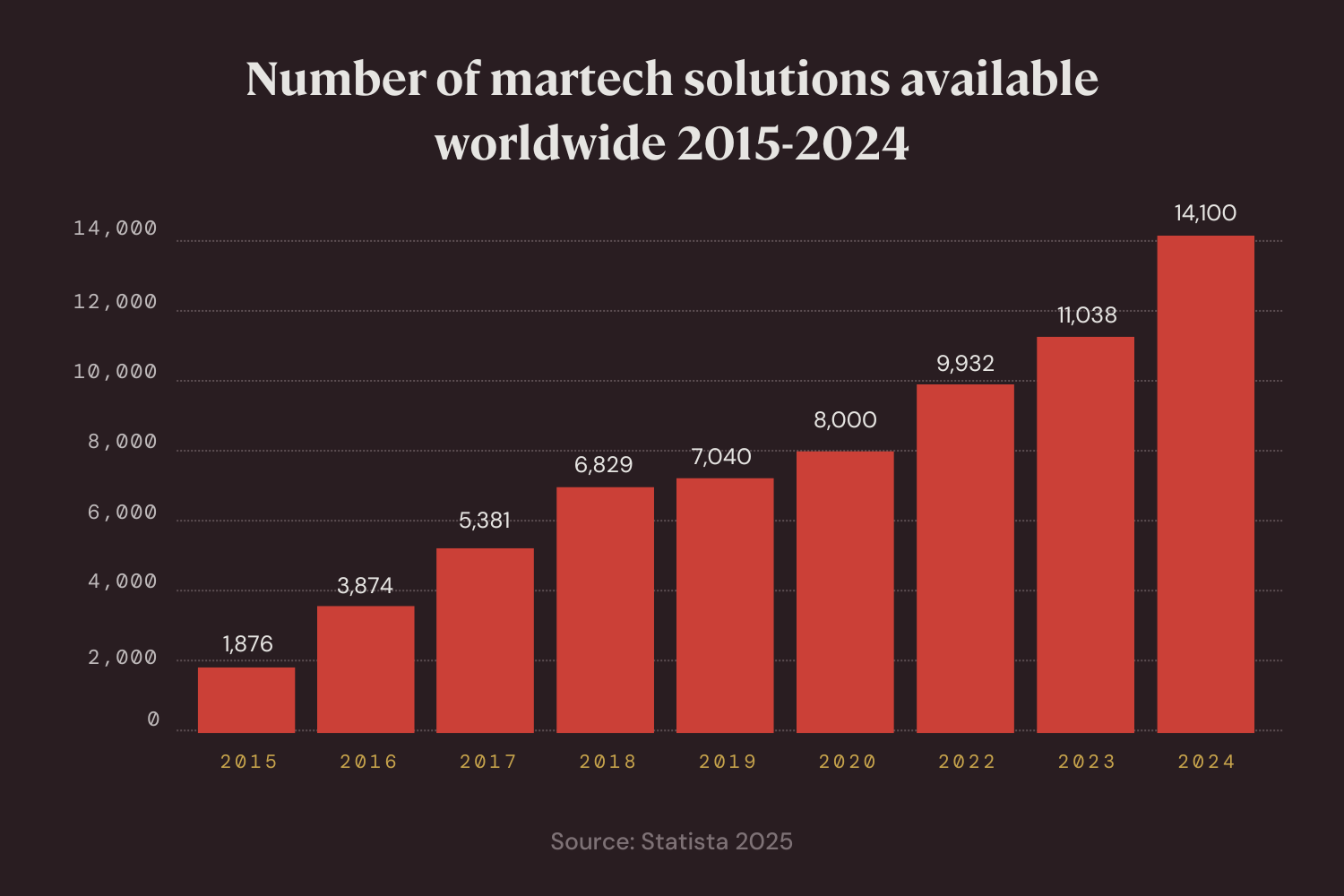Blog
3 ways to rein in your martech data chaos
Published on October 9, 2024

Navigating the abundance of marketing technology available today can often leave a marketer feeling a bit like a kid in a candy store. A 2024 global study revealed the number of martech solutions available to industry professionals has skyrocketed to over 14,000 options, marking a 100% increase since 2019. That’s a staggering array of tools at a marketer’s disposal.

While marketers are known to leverage dozens of solutions, Gartner reports that most are only using a third of their martech stack’s capabilities. With all these tools floating around at your company and data scattered across so many different platforms, it’s no wonder that maintaining control and coherence over your organization’s marketing efforts is such a struggle.
What’s the secret to reining in your martech data chaos? Let’s delve into three key strategies for bringing an overwhelming amount of data under control so you can unlock the potential of that data and maximize the value of your technology investments.
For starters, what is data chaos?
Data chaos happens when your customer data shared between different vendors becomes so complex and unmanageable that it creates a barrier to executing an effective marketing strategy. How many times has your marketing team shelved a campaign idea because they didn’t have the capacity or resources to bring it to life? That’s often a result of underlying data chaos.
As organizations adopt more marketing technologies to streamline their processes, gather customer insights, and execute targeted campaigns, they accumulate vast amounts of data from disparate sources, like CRM systems, CDPs, email marketing tools, website analytics, advertising platforms, and more.
For enterprise brands, this chaos leads to inefficiencies and inconsistencies across tools, which makes accessing data, streamlining workflows, executing campaigns, and extracting insights a constant uphill battle.
Why things get out of hand
So, why is it so common for data to turn into a chaotic mess? As you successfully drive growth, the complexity of your data landscape increases, and it becomes difficult to execute your customer data strategy at scale – especially when your tools aren’t built for brands working with massive amounts of data. As a result, the abundance of data living and moving within multiple platforms quickly becomes (you guessed it) chaotic.
Let’s dig into some of these problems that often send enterprise brands into a spiral.

Data silos and fragmentation
SaaS marketing tools operate independently and have their own unique architectures, collecting different types of data in various formats. When customer interactions and behavioral data are scattered across disparate systems and platforms, it becomes almost impossible to gain a unified view of customers, campaigns, and performance metrics.
Marketing ops, in particular, know too well how this fragmentation hinders their ability to consolidate, integrate, and activate data in meaningful ways. Without a centralized repository for data, marketing efforts become disjointed, leading to inefficiencies, missed opportunities for cross-channel optimization, and inconsistent messaging.
Breaking down these data silos and fostering integration is essential for streamlining operations, improving targeting accuracy, and driving meaningful results.
Data quality issues
With data flowing in and out of various sources, maintaining quality becomes a significant challenge, and it’s common for data to be incomplete, inaccurate, inconsistent, and duplicated.
Different platforms using varying data formats, naming conventions, and categorizations only add fuel to the fire, making it even harder to aggregate and compare data. For example, what one tool refers to as “engagement” might be labeled as “interaction” in another, which leads to unreliable insights and skewed analytics. The unique customer identifiers can be different across platforms too, making contact resolution a mess to wade through.
This inconsistency complicates data analysis and reporting and undermines the effectiveness of your marketing campaigns.
Data security and privacy concerns
With the increasing focus on data privacy regulations like GDPR and CCPA, it’s not ideal for marketing tools to have varying levels of data security and compliance standards.
This adds yet another layer of complexity to managing data and increases the risk of non-compliance with regulations. Trying to navigate these complex compliance requirements across systems exposes brands to unnecessary legal and reputational risks.
Limited resources and expertise
Integrating data from multiple tools is complex and time-consuming, often requiring significant time and resources. Many organizations lack the in-house expertise or specialized tools needed to effectively manage and consolidate data from various sources.
Even if they do have the tools, many of them lack robust integration capabilities, leading to manual data imports and exports. This manual process is time-consuming and prone to errors, making it challenging for marketers to sync data across platforms in real time. As a result, executing campaigns that could truly impact engagement and drive revenue becomes a distant dream.
In fact, in our recent report on customer engagement and AI, enterprise leaders said lack of expertise is the top challenge they’re facing when trying to implement AI into their already complex strategies.
Reining in data chaos
Data chaos hinders your ability to understand customers, fine-tune campaigns, and ultimately drive business growth. Tackling this challenge requires robust strategies for data governance, integration, and activation to make sure data remains a valuable asset rather than a source of confusion and inefficiency.
Use tools that connect directly to your central source of truth
Hands down, the best way to gain complete control over your data is to keep it within the secure environment of your data warehouse. Instead of data existing across multiple platforms in disparate silos, it lives in one place, maintaining the single source of truth for everyone.
Imagine a cross-channel engagement platform that can seamlessly access your data directly from its origin without needing to copy, map, sync, or store it in its own separate silo. This is precisely what MessageGears offers. This ensures data consistency, accuracy, and completeness – eliminating the need for manual data reconciliation and reducing the risk of errors and discrepancies.
Many vendors claim to offer direct data access, but marketing teams don’t realize there are often messy data pipelines and extra costs associated with this. MessageGears, on the other hand, is the only actual direct data connector CEP out there, so you can forget about hidden costs related to data storage, syncing, or mapping.
Overall, centralizing and accessing data directly from your data lake allows you to unlock the full potential of your rich customer data, so your marketing team can get campaigns out the door quicker, streamline campaign workflows, and capitalize on opportunities that once seemed out of reach.
Consider a composable CDP
Making the switch from a vendor you’ve invested significant time and money into is no easy decision and requires a meaningful cultural shift at your organization. Instead of diving headfirst into a complete overhaul, many brands are taking an iterative, composable approach to data transformation.
If you use a packaged CDP, you’re likely facing the common shortfalls associated with their typical one-size-fits-all approach. If you still find yourself struggling to set up automations or constantly resorting to workarounds for any kind of advanced personalization, it’s a clear sign your CDP isn’t flexible enough.
A composable CDP, on the other hand, lets you modularly assemble and customize your data management infrastructure, integrating with existing systems and adapting to evolving needs. The beauty of this architecture is you can start small and test for individual use cases to validate your approach before entirely abandoning your existing tools.
With a composable approach, you can select best-of-breed components that leverage your data right from the source and are tailored to your specific requirements. By breaking down the barriers between data collection, storage, management, and activation, you can tackle data fragmentation, integration challenges, and compliance requirements while maximizing your ROI.
Embracing a composable CDP empowers enterprise brands, in particular, to orchestrate their data ecosystem effectively, drive personalized customer experiences, and unlock actionable insights that fuel growth and innovation.
Get buy-in from leadership
Change is hard, and you’ll likely need commitment from your entire team to make it happen. Leadership will want to see how investing in a data solution aligns with core business objectives. Beyond highlighting the obvious benefits of solving for data chaos, initiating a proof of concept (POC) can be a tangible way of showcasing the positive impact of your proposed solution.
With MessageGears, setting up a POC is quick and easy because there’s no need for complicated data mapping, copying, or syncing. You can simply use queries you’ve already built internally for your current ESP or CDP and copy/paste them directly into the platform. You’ll also get a feel for the exceptional level of support you can expect as a customer during the process.
Once you’ve got your POC up and running, you can work with us to define success criteria and KPIs that you can use to evaluate the impact of the solution on your marketing goals. Set out some use cases that you want to test with your data and use the results to communicate the value and benefits to leadership.
By leveraging a POC to demonstrate the effectiveness and ROI of the solution, you can secure buy-in from leadership and pave the way for successful implementation and adoption to finally put an end to data chaos.
Maximize marketing impact
By leveraging these strategies, you can rein in your martech data chaos and unlock the full potential of your data assets.
At MessageGears, we’ve seen it all – the good, the bad, and the chaotic. We’ve helped countless enterprise brands navigate this journey, whether it’s a CDP switch or a fully composable approach to cross-channel customer engagement. Our experienced teams work with every brand to identify the best approach for their unique tech stack and data requirements.
We offer free POCs so you can test drive our solutions and we can help with your major CDP use cases, such as event collection, audience segmentation, and cross-channel data activation. Let’s work together to explore a better way to manage customer data and maximize your marketing impact.